The Best Haptic VR Devices and Innovations for the Real Feel in VR Environments
Virtual reality has been undergoing rapid evolution over the years. This is not just in terms of the hardware performance and the range of experiences but also in the development of peripheral experiences. Virtual reality is growing into deep realms of immersion and that requires replicating an immersive environment that is as close as possible to reality. One such technology is the incorporation of haptic capabilities into the VR environment that gives users a sensation of touch and even texture.
Below, we look at the various recent VR haptic developments. The products have been divided into the following categories:-
- Haptic VR Gloves
- Haptic Suits and Vests
- Haptic controllers, compressed air skin, brain stimulation and more
Haptic Virtual Reality Gloves
Dexmo Glove
Release Date: Dev Kit already released.
Platform: HTC Vive
Manufacturer: Dexta Robotics
https://www.dextarobotics.com/
Virtual reality haptic gloves work by translating hand movements into the VR environment with precision and providing the haptic force-feedback. Dexmo-Glove from Dexta Robotics is one such glove. The company was founded in China in 2014. The Dexmo Gloves are quite compact and provide great freedom of movement.
The Dexmo-Glove leverages claw-like robotic fingers which run over back of the wearer’s hand and end at the fingertips. The gloves should precisely track every finger movement while the resistance is simulated when the wearer of the love touches a virtual object.
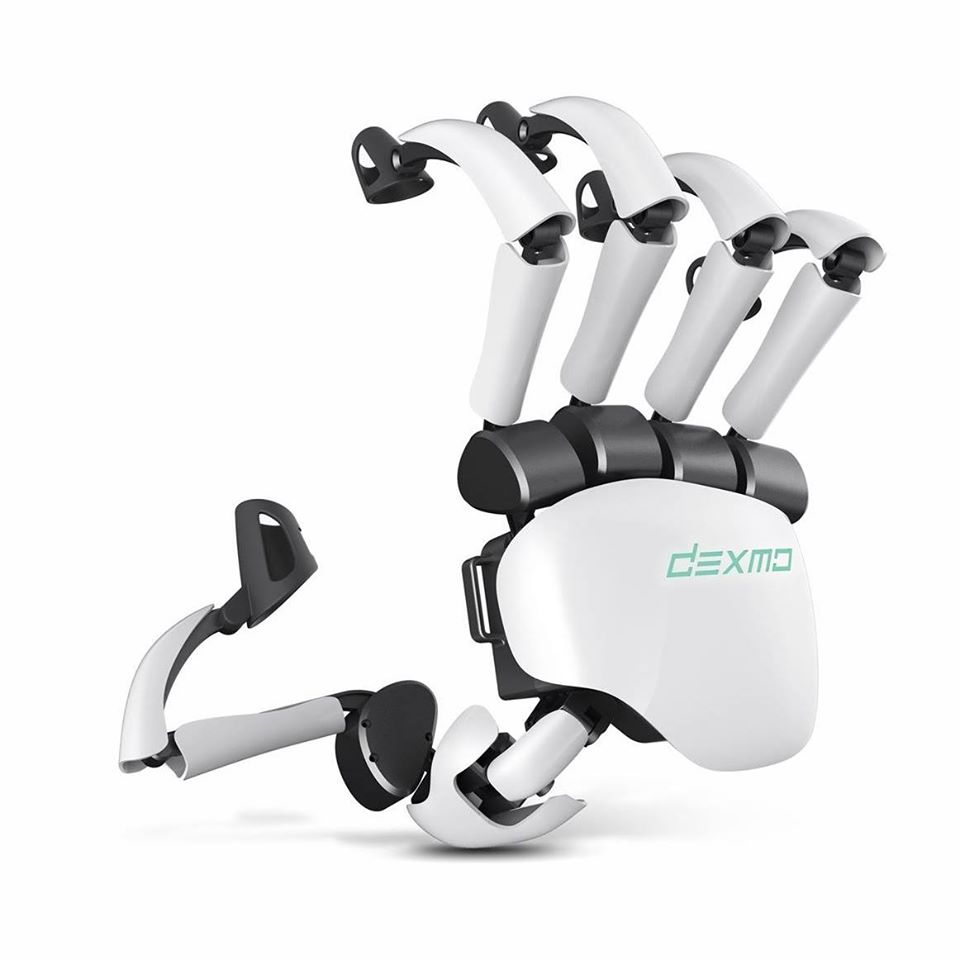
The company has initially envisioned developing consumer force-feedback virtual reality gloves but eventually pivoted to the enterprise market. Because the gloves are being sold on a case-by-case basis, the prices haven’t been revealed publicly.
The latest versions of the Dexmo Gloves are sleek and with a sharp design. The company’s closest competitor is currently HaptX haptic gloves which also offers great haptic and force-feedback functionality even though the latest HaptX designs remain bulky. The dev kit of the Dexmo-Glove already exists.
The Dexmo gloves have been described as some of the most easy-to-use force-feedback gloves. These haptic gloves are designed not only for enterprises and consumers but also researchers. The gloves have an intuitive and natural interaction which enable users to seamlessly touch immersive virtual worlds.
EXOS Wrist DK2 & EXOS Gripper
Release Date: Unknown
Platform: HTC Vive
Manufacturer: Exiii
Official website https://exiii.jp/
Price: Unknown
The Japanese company Exiii developed the EXOS wearable force feedback technology for virtual reality and augmented reality. The EXOS haptic technology consists of two products: EXOS Wrist DK2 and the EXOS Hand Unit (Gripper). The company released a new EXOS Wrist DK2 device that now promises a richer reproduction of haptic feedback including for weight, different hardness levels and the textures of virtual objects.
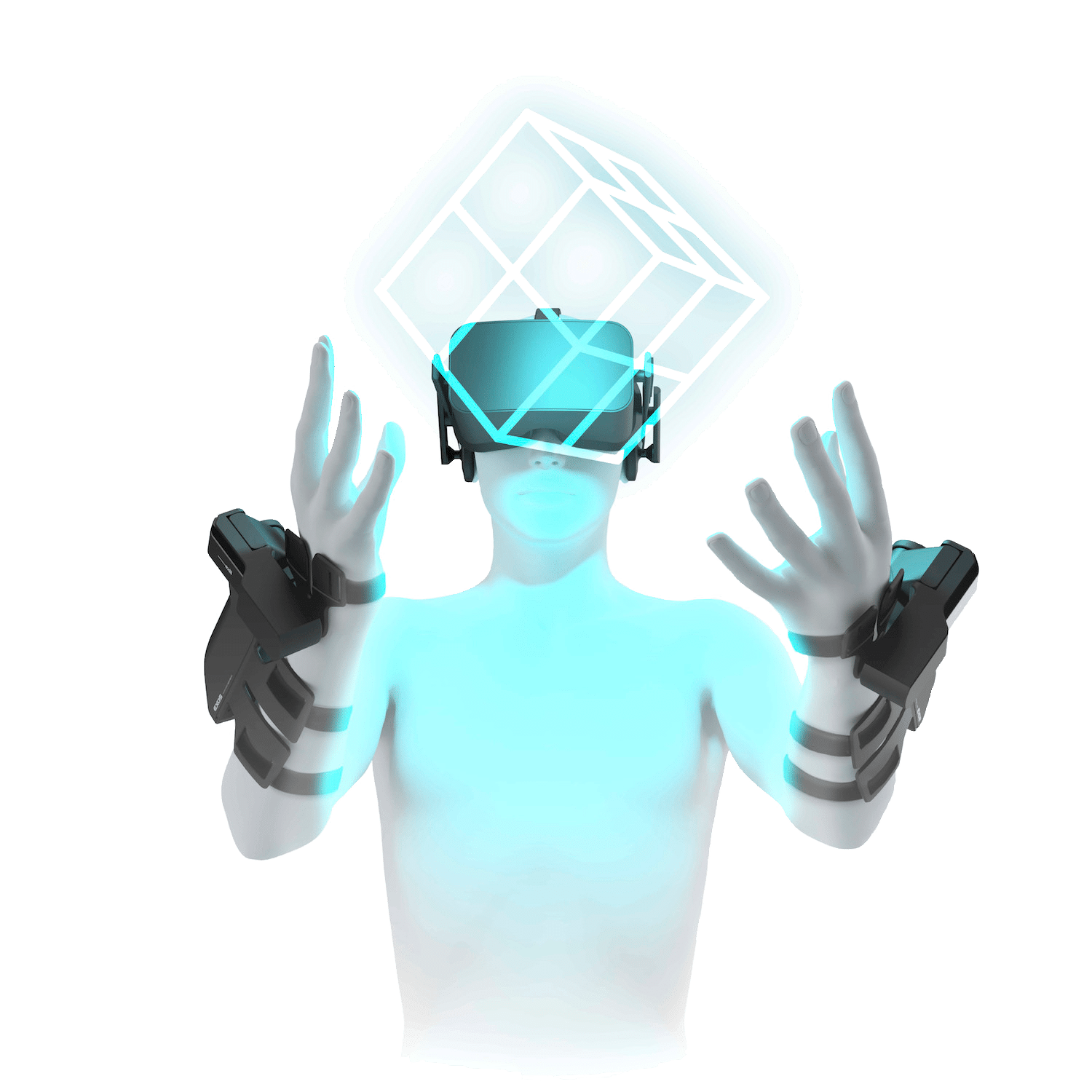
The EXOS Wrist DK2 applies a counter-force to two different directions- palm or dorsal flexion and the radial or ulnar abduction to simulate the virtual feedback when a user touches virtual objects. The device is now relatively lighter, weighing just 350 grams. This is now three times lighter than the previous EXOS Wrist DK1 model. With the reduction in weight, it is now possible to use the device with both of your hands for a longer duration of time.
The reduction in weight has also improved the wearability of the device which now handles different sizes of hands. The device is now more comfortable as the materials that come into contact with the skin are now sweat-proof.
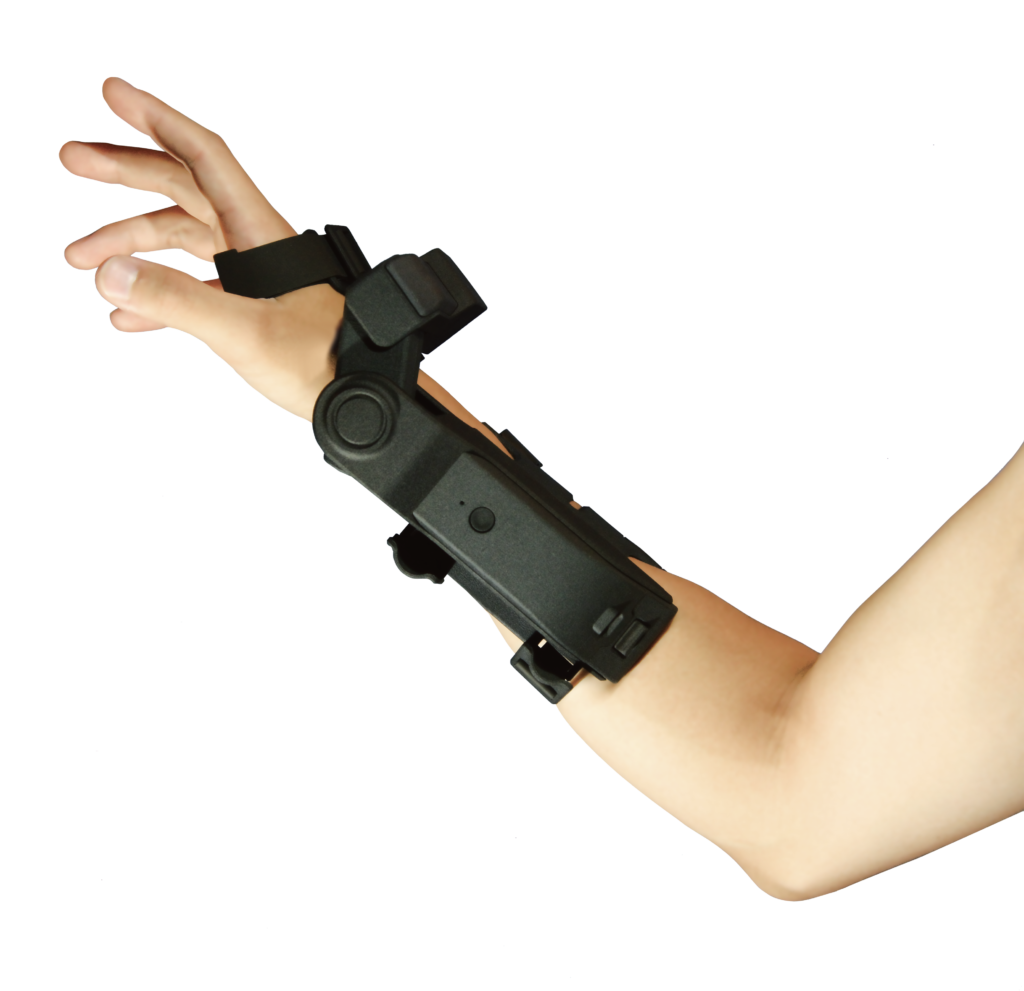
Because the users’ hands are always open, the EXOS Wrist DK2 device can be used with various peripherals such as Oculus Touch and the VIVE Controller. This makes it a lot easier for developers to translate VR contents or experiences into a touchable (haptic) experience.
There is also the EXOS Gripper which works like the replacement to the controller, like other gloves. The prototype of the EXOS Gripper resembles two hand puppets whose mouths can be moved using fingers. When this is squeezed, the virtual objects can be gripped.
The development kit for the EXOS Wrist DK2 will be launched with an updated Unity SDK, allowing developers access and control to a richer haptic feedback experience including weight, hardness as well as texture.
Forte Data Glove
Release Date: Unknown
Platform: Oculus Quest and HTC Vive
Manufacturer: BeBop Sensors
Website: https://bebopsensors.com/
Price: Upon Request
The Forte Data Glove can be used for virtual reality training as well as various other applications. According to the manufacturer, BeBop Sensors, these data gloves provide good immersion with low latency along with powerful haptic feedback. The gloves enable natural hand interactions as well as haptic feedback for the most immersive and intuitive virtual reality training scenarios for skilled workers.
According to the manufacturer, they offer powerful and very responsive haptics when it comes to the design of immersive touch feedback. They also offer a very robust software development kit (SDK), with multiple language binding, documentation as well as a sample code.
Compared to the other haptic gloves, the Forte Data Gloves are both light and flexible. They are built with ten bending and nine motion sensors that provide wearers with precise tracking functions.
A tracking update for the gloves is expected to be unveiled early this year which will make these gloves compatible with the Oculus Quest headset. The Quest controllers will be attached at the back of the data gloves.
HaptX Glove
Release Date: Not yet released.
Platform: HTC Vive with Quest support expected in early 2020.
Manufacturer: HaptX
Price: Upon Request
The HaptX gloves are the better known haptic virtual reality gloves. It is a premium haptic VR product. Like the Demo-Glove, the HaptX sensors also run from the back of the hand to the fingertips. Apart from this “Magnetic Motion Tracking”, the HaptX glove also has a smart fabric with microfluids, air cushions and a force feedback exoskeleton has been installed to provide a realistic touch, enabling users to feel texture, shape as well as the motion of VR products. There are up to 130 points of feedback that can displace the skin by up to 2mm without experiencing any perceivable latency.
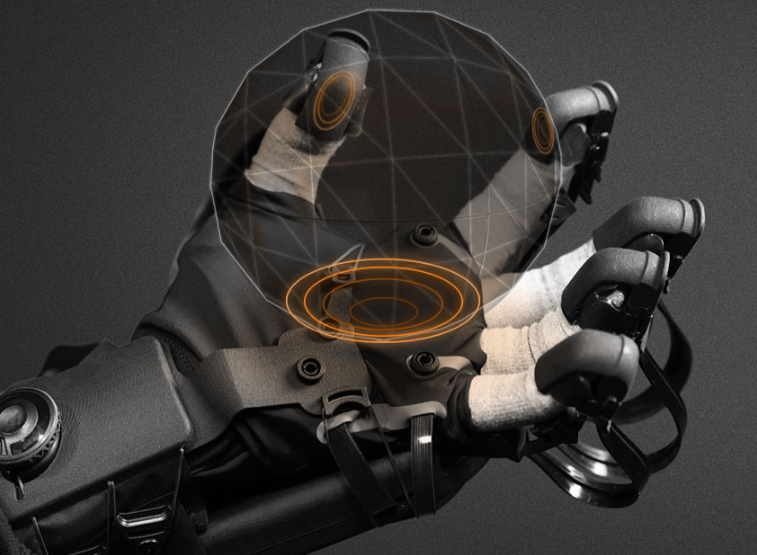
The haptic gloves also deliver a powerful force-feedback that enables users to feel weight, size as well as impact in VR. It has a lightweight exoskeleton that provides up to 4 lbs of resistive force feedback for every finger.
The extensive functions make this another ideal enterprise haptic glove. The product mainly targets the industry. However, it can still be put to entertainment uses, particularly in amusement parks and virtual reality arcades.
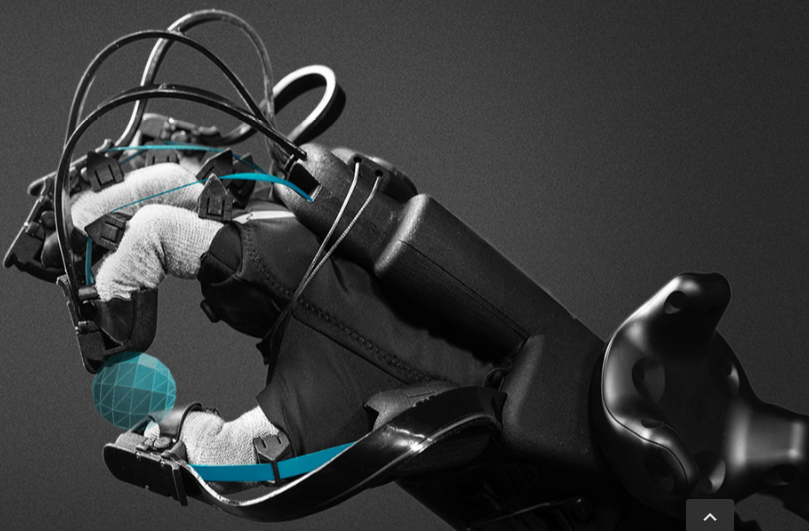
HaptX is currently working on the second generation of its current haptic glove. The company raised $12 million from investors in 2019 that will go towards this end. HaptX will also collaborate with the specialist company Advanced Input Systems in the future, a partnership that is further expected to entrench the glove’s suitability for industry-based applications.
Manus VR Prime Haptic
Release Date: Already released
Platform: HTC Vive
Manufacturer: Manus VR
Price: €4,990 (including the haptic module)
The Manus VR Prime Haptic gloves were originally intended for the individual or consumer market. The company shifted its approach and the haptic gloves are now primarily targeting business users. The pivot to the enterprise market had an immediate impact on the price of the haptic glove. While the initial consumer version was available for less than $300, the gloves now cost $5,000. But consumer VR is where the bulk of the user-base is and it is not out of question that this technology will one day make it to the consumer market.
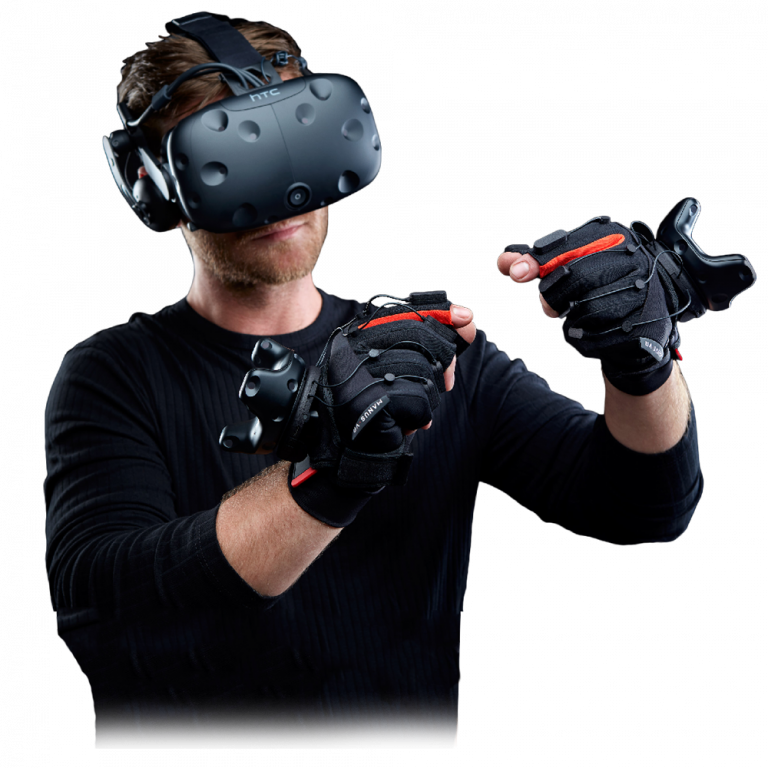
The Manus VR Prime Haptic come equipped with sensors which are installed on the back of the hand as well as below the fingertips. This allows for every movement or acceleration of the hand to be accurately reproduced in the virtual environment. A haptic module has also been attached to the back of the hand which transmits the corresponding impulses to the respective sensors.
As a haptic device, the Manus VR Prime Haptic is fairly sophisticated. However, if you are primarily interested in virtual reality games and apps, you can try other more affordable options. There are different versions of the Manus VR Gloves including the Manus Prime One, Manus Prime XSens and the Optitrack Gloves.
Plexus VR Glove
Release: Already released (dev kit)
Platform: Oculus Rift, HTC Vive and Windows Mixed Reality
Manufacturer: Plexus
Price: $249
The Plexus VR Glove is a high performance AR/VR glove designed more for consumer use than enterprise use. It has a simple design and structure with sensors that guarantee the precise tracking of movements. The haptic glove tracks not only the fingers but also the individual joints of the hands. Five actuators at each of the fingertips provide the haptic feedback.
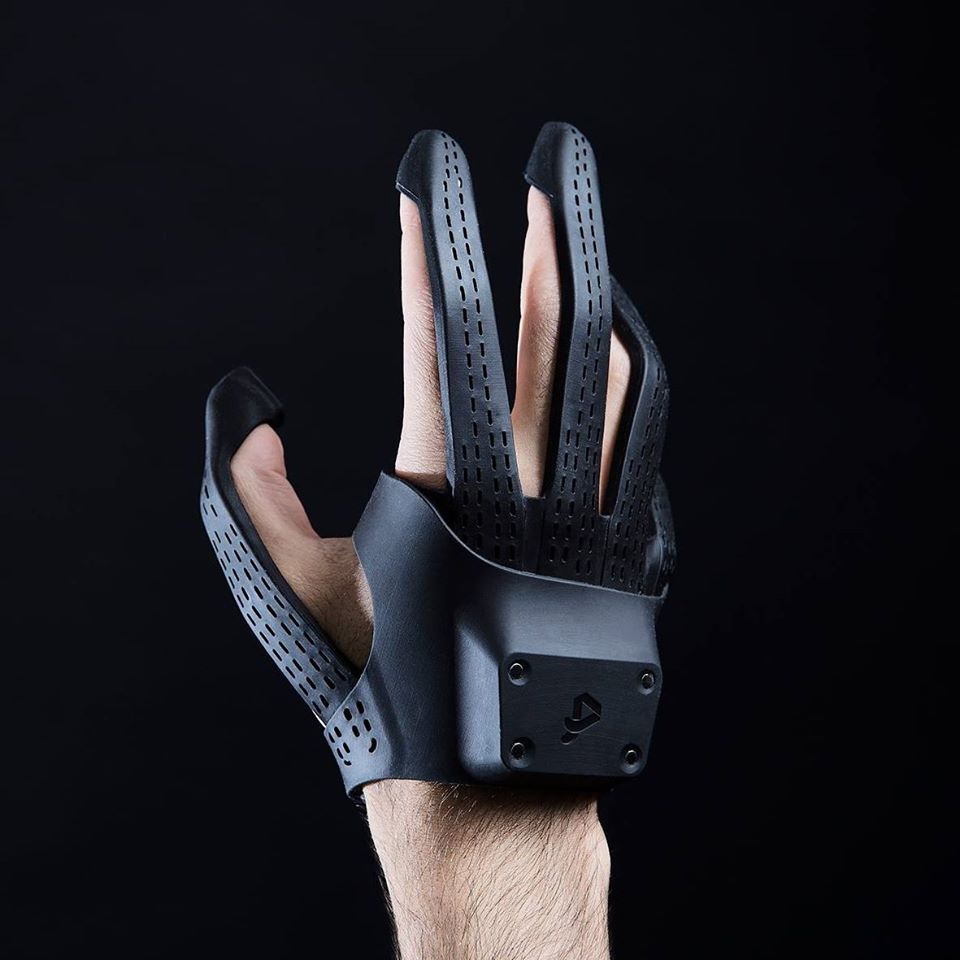
A number of devices can be attached to the back of the glove including HTC Vive and Oculus Touch motion controller. Plexus is currently accepting orders for the developer models of the Plexus VR Glove through its website.
Skin Stretch Instrument
Release Date: Unknown
Platform: Unknown
Manufacturer: Oculus VR
Price: Unknown
The “Skin Stretch Instrument” is still just a patent which was filed by Oculus VR last year. The patent describes a technology which allows the deformation of fingers on real objects to be transmitted to the virtual world. It isn’t clear yet whether the patent will see the light of the day and be implemented. Should it be developed, it would simply be in the form of a glove.
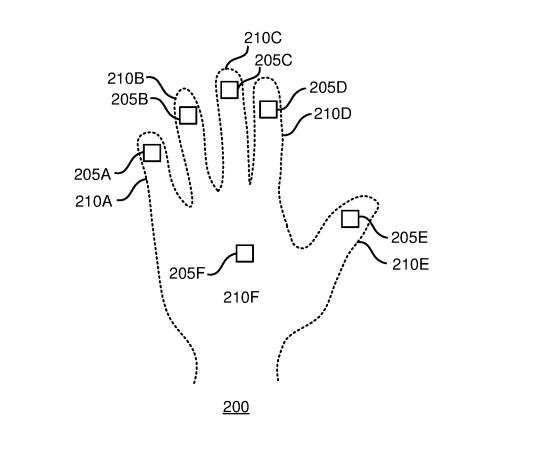
Our hands cradle objects in different ways. How we hold a smartphone, for example, is different from how we hold a stick or a fruit. The Oculus patent describes a haptic glove which is capable of calibrating itself just by monitoring how the hands interacts with different objects. The skin stretch instrument describes a technology that will be in the fingers, fingertips as well as the palms of the haptic glove. The haptic technoloy will be measuring how the skin stretches or compresses when a user holds real-world objects. By obtaining these measurements, the haptic glove will calibrate itself to simulate how the sin behaviors with different kinds of pressure.
VRgluv
Release Date: Unknown
Platform: Oculus Rift and HTC Vive
Manufacturer: VRgluv
Price: $399
The VRgluv utilizes a combination of precision hand tracking and force feedback technologies to bring virtual objects right into the user’s hands. The haptic gloves enable you to virtualize your hands. When you wear them, you will see your hands in VR. It precisely captures every motion of the fingers thereby making your virtual reality interactions more intuitive and lifelike.
The design is weightless and wireless and enables the wearer to move freely within their virtual environment without having to grapple with cumbersome cabling, frustrating controllers. Apart from its finger tracking feature, the haptic glove also has an exoskeleton that provides the haptic feedback. In spite of the lightweight, the form factor is still big and it looks more like a boxing glove rather than normal gloves.
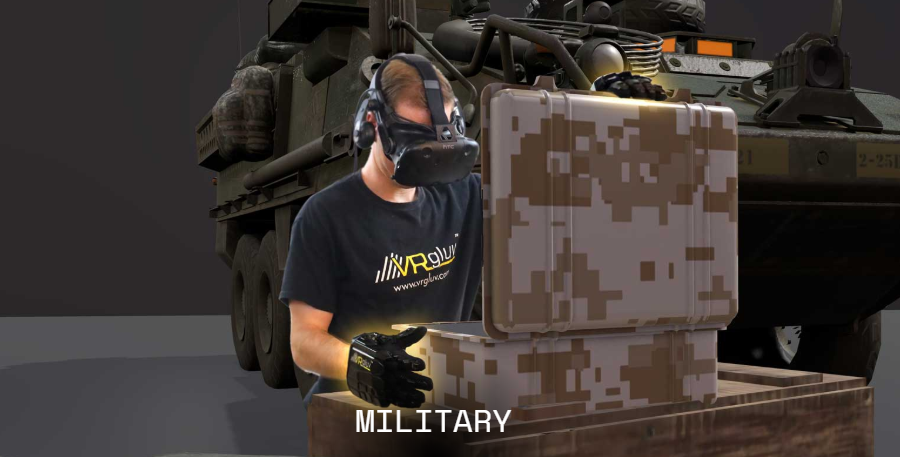
VRgluv is fundraising via a Kickstarter and it has so far had a successful Kickstarter campaign. The campaign backers were supposed to receive the haptic glove by the end of 2017. The date was shifted to mid-2018 and up to now, the product is yet to be shipped to its backers.
Haptic Suits and Vests
Disney Force Jacket
Release Date: Unknown
Platform
Manufacturer:
Price: Unknown
Disney collaborated with researchers at MIT and Carnegie Mellon University to develop a wearable pneumatically-actuated haptic jacket prototype which lets you feel hugs and punches in VR and AR experiences. According to Disney, the jacket even lets you feel a snake slithering around your body in immersive VR experiences! The force jacket could be used in theme parks in the future. The 26 chambers can be quickly filled with air and then emptied again with a compressor to simulate various force feedbacks. .
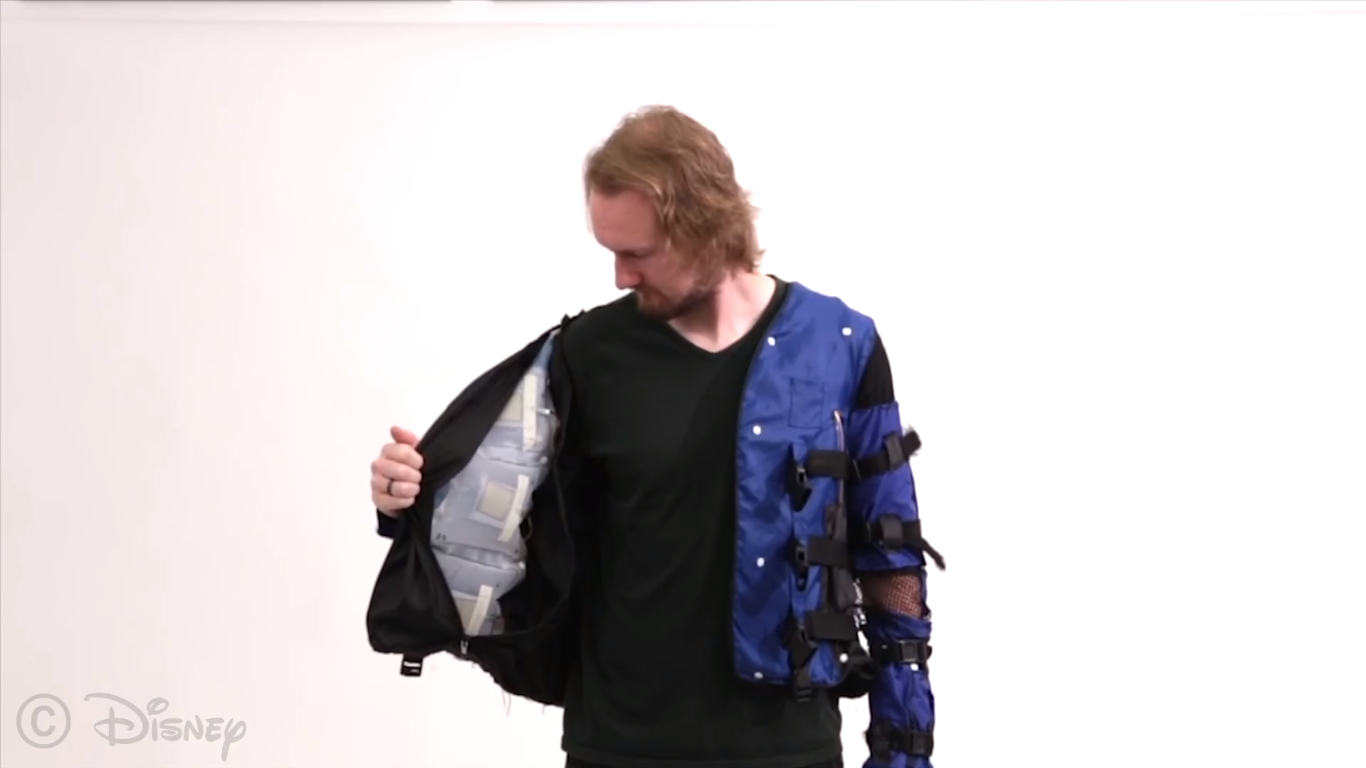
Additionally, the haptic vest deploys high-frequency vibrations to create a sensory perception on the body. This haptic vest project is still in early development.
Exoskin Haptic Jacket
Release Date: Released (Dev-Kit)
Platform: Oculus Rift
Manufacturer: Neo Sensory, High Fidelity
Price: $399
The Exoskin haptic device is in the form of a jacket that is designed to transmit haptic perceptions precisely to the user in real-time through sensors. The virtual reality platform High Fidelity is involved in this ambitious haptic feedback project in collaboration with the technology manufacturer Neo Sensory.
The Exoskin haptic jacket uses 32 sensory motors. The haptic device interface with High Fidelity’s open-source architecture for hardware devices.
The wearer is able to feel in real-time, the precise haptic sensations that are transmitted between the users in the virtual environment. The speed of signalling is ultra-fast and as a result, the wearer is able to feel these sensations -such as an avatar’s touch or graze- almost immediately. It is even possible for two people to dance together in virtual reality and cue off one another’s touch.
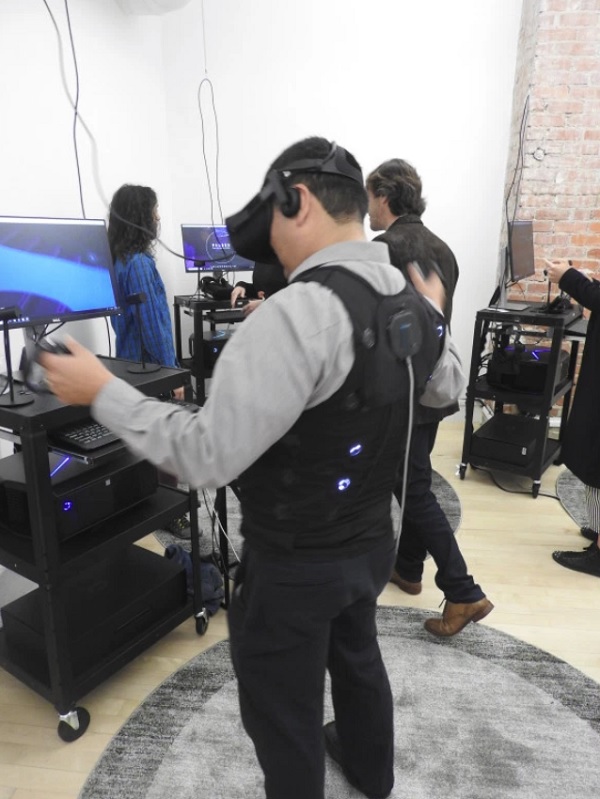
The jacket has a haptic feedback that can be triggered even by virtual explosions and rain. The jacket gives users some kind of sixth sense, the kind you are likely to feel in the real world. For example, approaching opponents in a virtual reality game will trigger vibrations which warn the player. There is an Exoskin cheat jacket that costs less and is better suited for individual players. However, there is currently no page for the Exoskin manufacturer which does not bode well for the future of the gadget.
HoloSuit
Release Date: Released
Platform: Oculus Rift, HTC Vive, Windows Mixed Reality, Samsung Gear VR, HoloLens
Manufacturer: Kaaya Tech (HoloSuit, official website)
Price: $1,499 for full kit.
HoloSuit is a full body suit so it goes the extra mile in offering users haptic feedback in various places. The Kaaya product was financed via a Kickstarter crowdfunding campaign and can be put into various use-cases including education, gaming medicine as well as training for factory workers.
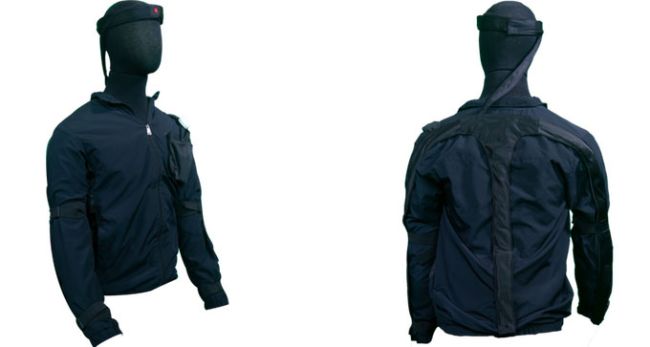
HoloSuit has 26 motion sensors, nine haptic motors and six control buttons to meet the requirements of various sectors. The Pro version has ten additional sensors which will cost you a few hundred dollars more. The price for the full kit is inclusive of the virtual reality gloves, pants as well as a jacket with a headband. Kaaya Tech sells the Holosuit offering piece by piece. The Jacket and Jersey costs $499; the jersey of track pants costs $399 while a pair of gloves goes for $799. The full Holosuit kit costs $1,499.
Woojer Edge
Release Date: Unknown
Platform: Oculus Rift, HTC Vive, PlayStation VR, Oculus Go and Samsung Gear VR.
Manufacturer: Woojer (Official website)
Price: $270
Woojer Edge is a haptic vest designed to make entertainment software, film and music more perceptible. The vibrations in the vest can be triggered either by sound (with the pitch determining the intensity) or they can be specifically programmed. The latest version of the Woojer Edge even makes a virtual punch in the corresponding part of the body noticeable and developers have to program the individual pulses.
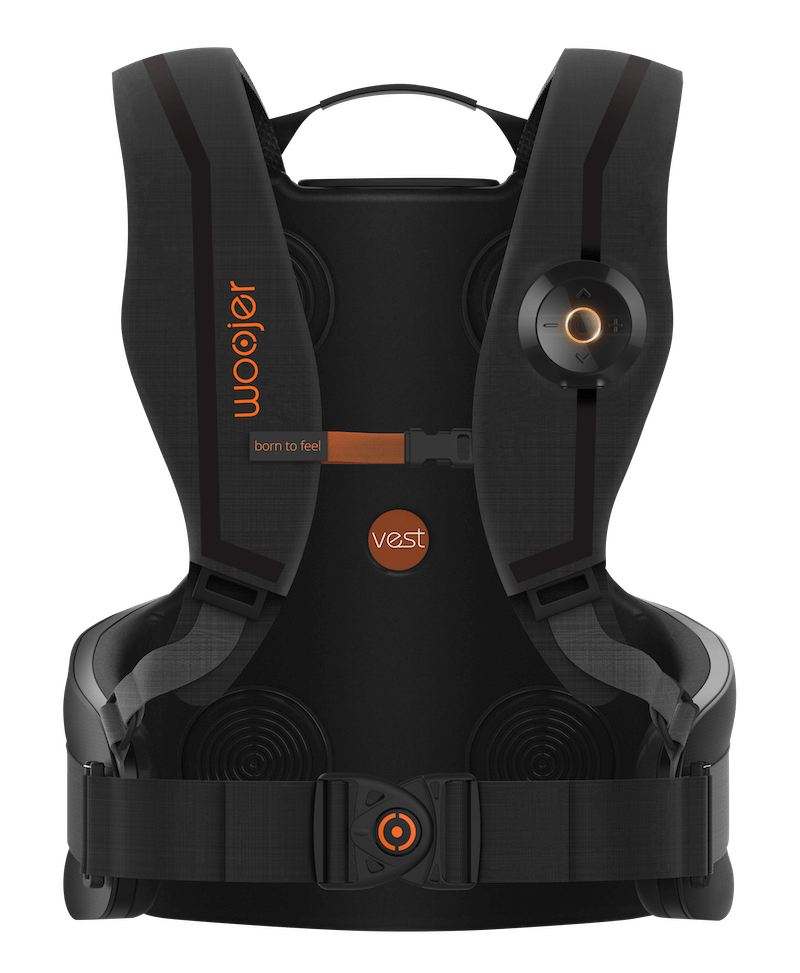
The Woojer Edge technology can be purchased as a vest (with six vibration speakers) or as a strap around the chest or waist (one speaker). To use Woojer Edge together with the virtual reality headsets, you will need external headphones.
Like the other haptic projects, Woojer Edge turned to Kickstarter, raising about $1.9 million. With a starting price of just $270, the technology is fairly affordable and has been designed for the consumer market.
Teslasuit
Release Date: Released
Platform: Oculus Rift
Manufacturer: Teslasuit (Official Website)
Price: $1,350
Like the HoloSuit, the Teslasuit is also a multifunctional VR body suit. The haptic feedback in this bodysuit is not just limited to the vibrations which specifically stimulate the nerves in the body. The Teslasuit is also able to detect temperature fluctuations in the range of 20 to 40 degrees Celsius.
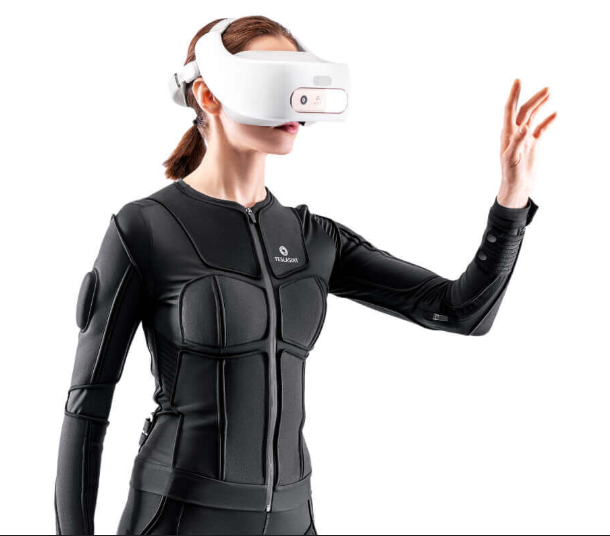
For instance, if a player is running through a desert in the virtual reality game, it gets hotter. If the player is in the mountains, the temperature gets cooler. Additionally, Teslasuit can also be used for motion capturing thereby transferring the entire body into the digital world.
The haptic bodysuit leverages 46 haptic simulation points, 14 motion capture sensors as well as ten climate controls to make this work. The price ranges from $1,350 to $2,400 depending on the equipment.
Haptic Controllers, Compressed Air Skin, Brain Simulation and More
CLAW
Release Date: Unknown
Platform: HTC Vive
Manufacturer: Microsoft
Price: Unknown
CLAW is a multifunctional handheld haptic controller for VR applications which is still under development at Microsoft. The product only exerts pressure on the fingertips. Microsoft says this should still create an immersive experience. It can be used for touching, grasping or triggering in virtual reality. CLAW simply augmented the normal controller functions through force feedback as well as actuated movement to the user’s index finger.
CLAW provides three distinct interactions: grasping of virtual objects, touching virtual surfaces and a triggering function. The device subsequently shifts the corresponding haptic rendering by sensing the differences in the surfaces that the user is grasping.
The device also features a servo motor that is coupled with a force sensor. This renders the controllable forces to the user’s index finger when they are touching and grasping. Through position tracking, a voice coil actuator situated at the index fingertip will generate the vibrations for the different textures which is synchronized with the finger movement. CLAW also provides a haptic force feedback in its trigger mode when a user is holding a gun.
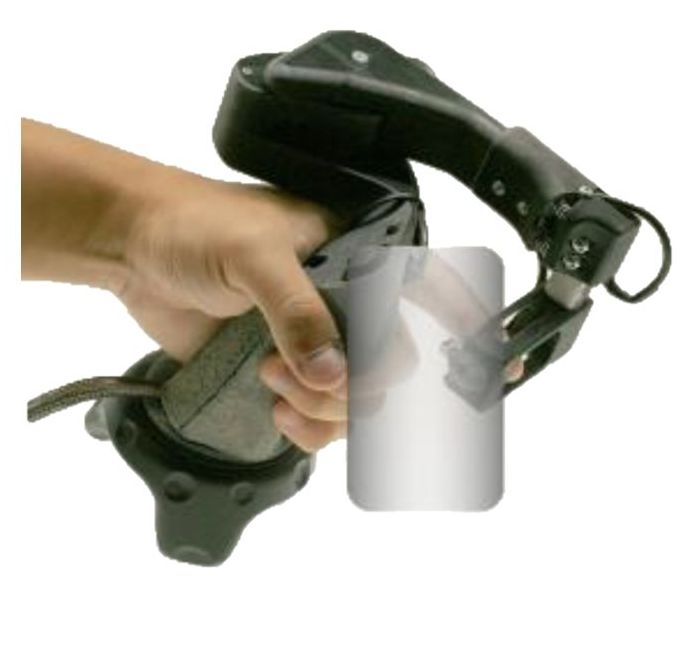
Apart from the resistance functionality which, for instance, makes the trigger of firearms feel more realistic, this haptic device can also simulate the surface of touched objects. Stones will feel rough and windows will feel smooth. CLAW is currently just a prototype in Microsoft’s labs.
Experimental Compressed Air Skin
Release Date: Unknown
Platform: Unknown
Manufacturer: Eidgenossische Technische Hochschule Lausanne
Price: Unknown
Developed by the researchers at the Technical University of Lausanne in Switzerland, this is an artificial skin which can simulate the sense of touch through the use of compressed air. This creates a grid of small air bubbles located between two thin silicone skins. The device’s software then sends the relevant signals to the artificial skin which increases or decreases the amount of air bubbles to regulate the sense of touch.
In theory, an entire clothing or body suit can be made from this artificial skin. This is still an experimental technology and it remains to be seen whether it will see the light of day as a usable haptic product.
Brain Stimulation for VR Feeling
Release Date: Unknown
Platform: Unknown
Manufacturer: Eidgenossische Technische Hochschule Lausanne
Price: Unknown
This haptic innovation was developed by researchers at Lausanne University. Instead of stimulating the skin or creating a sensation via air bubbles or air pressure, it taps directly into the brain.
It uses a so-called rubber-hand illusion which describes a phenomenon where humans consider an artificial hand to be real as long we are not clearly seeing that it is our own. During the tests on subjects, certain brain regions of the subjects were simulated while they were immersed in virtual reality experiences. Most of the test subjects felt momentarily that the digital hands were their own.
Haptic Links
Release Date: Unknown
Platform: HTC Vive
Manufacturer: Microsoft
Price: Unknown
Haptic links consists of electro-mechanically actuated physical connections which can render variable stiffness between two handheld VR controllers. When the Haptic Links are attached, they are capable of dynamically altering the forces which the user is perceiving in their hands. This makes it possible for the device to support the haptic rendering of various two handed interactions and objects.
The controller is designed to solve a specific problem: normally, if users hold a virtual object in both hands by using two motion controllers they are is still able to move freely which ruins the immersion. For example, if a user sits on a steering wheel or holds a rifle, an immersion break happens.
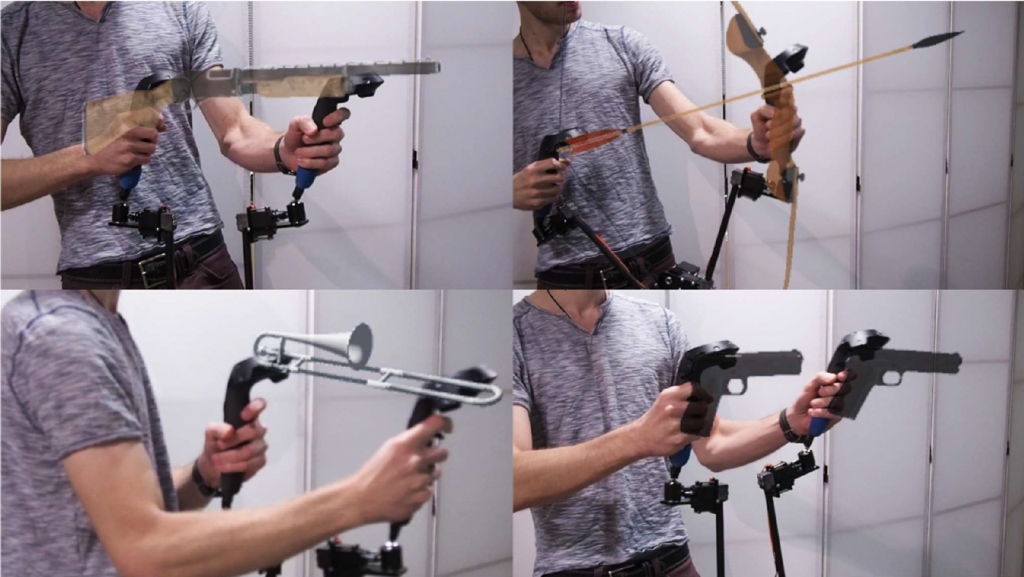
Haptic Links solves this problem by bringing an elastic connector that will solidify when both hands are used to hold the same object. This provides the user with feeling that they actually have a solid object in front of them or in their hands. Haptic Links can rigidly lock the controllers within an arbitrary configuration thereby limiting specific degrees of freedom or directions of motion. This way, the haptic device is able to dynamically introduce stiffness on a continuous range.
STRATOS
Release Date: Released (Dev-Kit)
Platform: Unknown
Manufacturer: Ultrahaptics
Price: Unknown
STRATOS is yet another ambitious bid at haptic technology. The STRATOS platform by Ultrahaptics was designed to enable users to have touch-based sensations in mid-air. There is also the STRATOS Explore which is the platform’s first development kit.
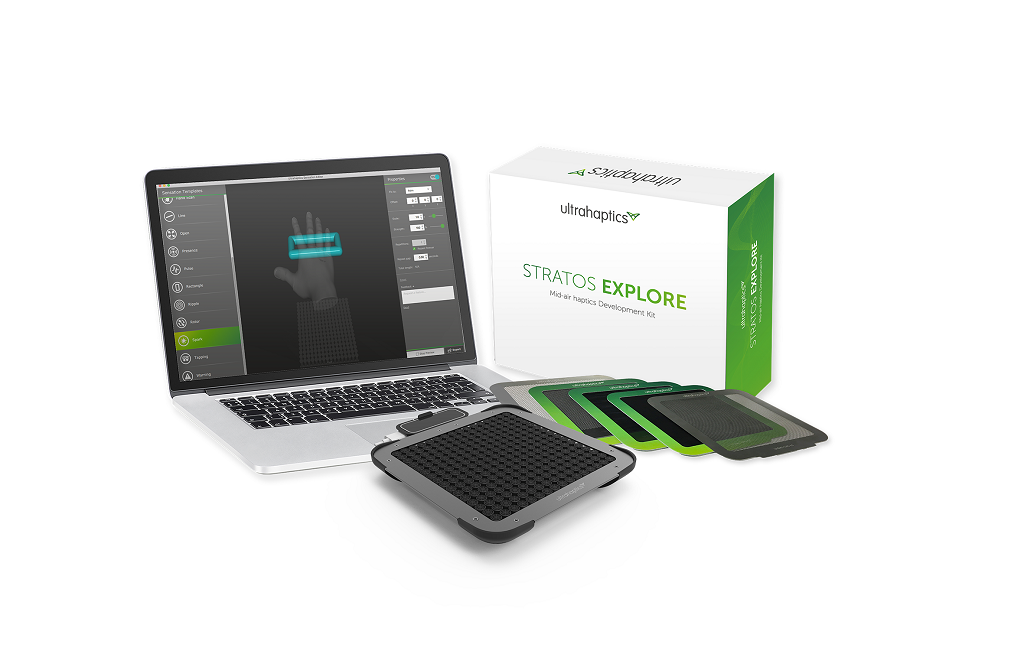
The specific areas of application for this technology are yet to be shown, though. This device creates the feeling of air resistance via ultrasonic waves. In terms of immersion, this can be an excellent immersive technology as nothing else has to be worn on the body.
However, STRATOS is better suited for use on the computer-more traditionally, while one is sitting without the movement-intensive VR. This is because with movement, the generated field has to adapt to the position and movement of the user.
VR Sex Doll
Release Date: Unknown
Platform: Unknown
Manufacturer: CamSoda, RealDoll
Price: $1,500
The CamSoda VR Sex doll is an impressive piece of VR sex device. CamSoda is already active in the adult entertainment industry and operates a webcam site. Its VR sex doll is definitely a taste of things to come in the industry where experiences will get more immersive and less passive in the future.
The virtual reality doll was made by RealDoll and it embodies a distant sex companion in front of the camera. This could be the actress of the cam show. Not only is the video stream of the performance transferred to the virtual reality headset but you are actually able to see the unique movements of the webcam actress on the VR sex doll.
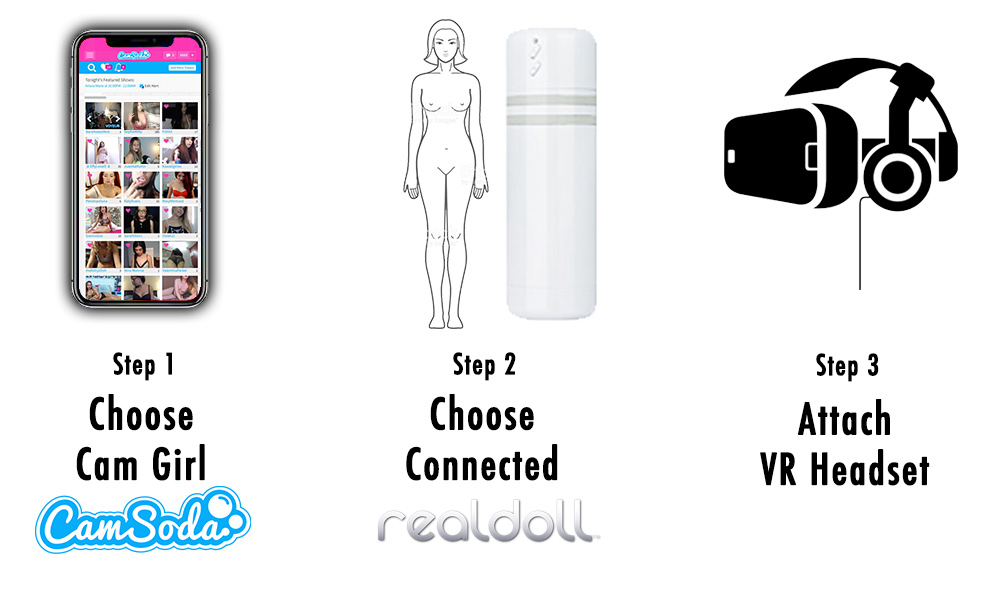
You will need a special dildo for this which will transmit the signals to the artificial sex partner-the doll. The abdomen of the doll will move exactly like that of the real actress.
The whole CamSoda VR sex doll concept still sounds a bit complicated and it is certainly not a replacement for real sex with an actual human being. The costs also lie in the four-figure range which is expensive for something that is not really bringing out an ultra-realistic immersive sexual experience. The costs vary depending on whether the user wants to purchase a complete doll or just the torso.
Sex with an artificial human being is still a long way from realization although the porn industry, one of the most-innovative and forward-looking technology-wise, is not to be underestimated. The porn industry has always been the driving element in the evolution and performance of new digital innovations.
Haptics
Haptic refers to the sensation of touch which simulates the feeling of touching something. Force feedback, on the other hand, refers to the ability of the virtual object to push back against your fingers thereby creating the sensation of grabbing virtual objects which aren’t actually there physically.
Virtual reality haptics technology creates a completely new dimension in VR experiences, away from the visual and audio experiences. Being able to see, hear, touch and smell virtual reality environments will enable future developers to closely simulate reality and create environments that feel just like the real world.
Just like VR hardware, haptic technologies are also undergoing rapid evolution. The technologies are growing beyond the creation of rudimentary vibrations into more granular haptic sensations. In the future, VR users might even be able to cuddle dogs, feel the texture of clothes and other objects in virtual reality. Users might even feel a virtual dog licking their faces!
A multiplicity of haptic sensations will make users feel as if they are right in the thick of things in Virtual Reality. Haptic sensations will find application in diverse environments. For gamers, the perfect multi-sensory immersion if of a course a dream come true. A virtual reality experience with a high-degree of immersion also offers hardware and software developers plenty of new options with which to realize the perfect immersion.
When it comes to haptics, there is already a range of devices which have the potential to materialize into workable products even though the dream of the perfect haptic sensations is still a vision of the future. Some innovators are already ahead of the curve and there are niche haptic products that are already deployable.
When it comes to generating sensations in virtual reality, the focus of most haptic research is currently in the creation of the sense of touch in VR.
Virtual reality arcades with their elaborate VR hardware installations are the forefront of delivering deeper immersion for users that might include the haptic aspect. The range of haptic devices, whether concepts or prototypes, is quite broad and include gloves, bodysuits, vests and even sex dolls!
https://virtualrealitytimes.com/2020/01/30/the-best-haptic-vr-products-for-the-best-feel-in-vr-environments/https://virtualrealitytimes.com/wp-content/uploads/2020/01/EXOS-Wrist-DK2-600x600.pnghttps://virtualrealitytimes.com/wp-content/uploads/2020/01/EXOS-Wrist-DK2-150x90.pngHapticsHardwareVirtual reality has been undergoing rapid evolution over the years. This is not just in terms of the hardware performance and the range of experiences but also in the development of peripheral experiences. Virtual reality is growing into deep realms of immersion and that requires replicating an immersive environment...Sam OchanjiSam Ochanji[email protected]EditorVirtual Reality Times - Metaverse & VR
